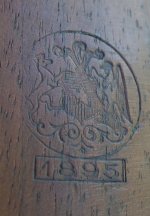It always amazed me how these rifles can be found in such remarkable condition. The fit and finish was always the best and to build something like this today would be, in my opinion, up there with a custom built rifle. There will never be anything like this mass produced again.
This is the latest pick up, an 1895 Chilean rifle in 7x57mm built by Ludwig Loewe of Berlin. It's practically unissued and only has a few dings here and there, mostly on the stock. When I saw it I knew it had to come home with me.








This is the latest pick up, an 1895 Chilean rifle in 7x57mm built by Ludwig Loewe of Berlin. It's practically unissued and only has a few dings here and there, mostly on the stock. When I saw it I knew it had to come home with me.










